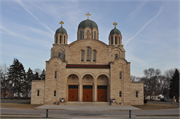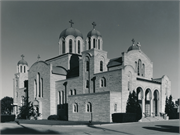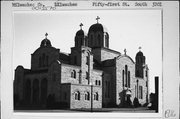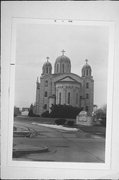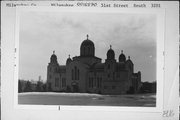| Additional Information: | "A 'site file' exists for this property. It contains additional information such as correspondence, newspaper clippings, or historical information. It is a public record and may be viewed in person at the Wisconsin Historical Society, State Historic Preservation Office.
2023- resurveyed as part of Milwaukee Houses of Worship thematic survey.
St. Sava Serbian Orthodox Cathedral is one of Milwaukee's newer churches, but it represents a thousand-year-old architectural tradition. The stone building is a modern rendition of middle- and late-Byzantine church forms that originated in the eastern part of the Holy Roman Empire, alias the Byzantine Empire, home of Orthodox Christianity. Regional variations of the style appear in Russia, Turkey, and elsewhere. Domes are the architectural focal point of Byzantine churches. St. Sava's roof is topped with five copper-clad domes on tall windowed drums, a plan common in Serbia and other Orthodox regions. Other Byzantine features include the tall, thin-arched, or curving exterior elements that repeat in the narrow windows and the entrance portico. Since Eastern Orthodox tradition eschews three-dimensional carved statues, the exterior carving of St. Sava's is limited to stylized, decorative shallow-relief motifs. Inside the cathedral are stunning mosaics designed in Ravenna, Italy. The mosaic images follow the usual Byzantine hierarchy showing Jesus in the main dome and Mary in the semi-dome on the apse, biblical figures below and saints closest to the pews. The graduated dome and vault design coordinates well with the levels of images. An iconostasis separates the clergy from the laity, repeating the use of such screens used for several centuries in western churches.
""Representing a 1500-year-old architectural tradition, St. Sava Serbian Orthodox Cathedral is a remarkable, modern, Byzantium style stone church that is widely known for its spectacular interior mosaics. Byzantine architecture developed in the eastern part of the Holy Roman Empire in the sixth century and eventually regional variations of the style spread to present-day Serbia, Russia, and other areas of eastern Europe. While western churches usually feature tell pointy steeples and towers, a dome is often the architectural focal point of a Byzantine style church. St. Sava's roof is topped with five copper-clad domes on tall windowed drums. Domes of this unusual type are among the most definite elements of Serbian ethnic architecture. The repetition of tall, thin arched or curving elements on the exterior, such as the narrow windows and the attenuated entrance portico are especially characteristic of this eastern architectural tradition. Since three-dimensional, carved statues are not part of the Orthodox Christian tradition, a special painting or mosaic called an ""icon"" is the principal means used to depict a religious figure or scene in a church. The interior of St. Sava's is adorned with stunning mosaics made in Ravenna, Italy that are some of the finest of their kind installed in any American church during the last half of this century. Mosaic art is made of tiny chunks of glass tile and marble that are set in wet plaster to form a picture. Because the pieces are set individually at slightly different angles, the surface has extraordinary light-reflective qualities that no other flat art form can match. The Milwaukee area has one of the nation's largest populations of Serbian-Americans. Large numbers of Serbians began arriving in America after 1880 and particularly between 1903 and 1909. Like other Eastern European immigrants, many Serbians initially found work in heavy manufacturing, but over the years they have moved into all types of occupations. Serbian immigration still continues today, although at a rate that is much slower than at the turn of the [20th] century. St. Sava's is one of the newest additions to Milwaukee's fine stock of ethnic churches, but its traditional design and fine craftsmanship have already earned it a place of distinction among the city's other, older historic churches."" MILWAUKEE ETHNIC CHURCH TOUR, CITY OF MILWAUKEE DEPARTMENT OF CITY DEVELOPMENT, 1994." |
|---|

